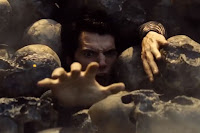Welllllll… guess there’s no putting this off, is there? In the end, this is where every story leads in the long run. I’ve crafted a fantastic character with
some wonderful nuances and habits, and
a detailed backstory. It’s a character every reader can picture in their minds and relate to on a personal level.
And it’s time to slit their throat. Or watch them die from an awful disease. Maybe even have a zombie horde devour them.
Killing characters in a story is a delicate thing.
I don’t mean this in some artsy, poetic way.
I mean it more in a “stitch up that major artery up before he bleeds out” way. It’s something that has to be done just right for it to work. And just like stitching up an artery, if I’m only going to do
a quick, half-assed job with it… I mean, why even bother?
Here’s a couple of loose guidelines for killing someone…
 First
First off, if I’m going to kill a character… well, I need a character, right?
A real character.
I can’t expect there to be a lot of emotional impact from the death of a paper-thin stereotype.
I mean, killing paper-thin stereotypes is cool if I just want to
drive a body count, but it’s not going to drive a plot and it’s not going to motivate anyone on a personal level.
It’s not going to affect the reader, either.
I can’t create Phoebe on page fifty, kill her on page fifty-one, and think it’s going to have any emotional weight—with the other characters or my readers.
Second, this death needs to drive my plot forward. That’s what good story elements do, right? They keep the narrative moving—not necessarily upward or into positive place, but forward. Killing a character who’s well-developed but has no connection at all to the plot doesn’t really do anything.
We’ve probably all seen storytellers who
create unconnected charactersjust to kill them off a few pages later.
The plot’s heading into act two and we pause to meet Phoebe.
She’s thirty-three, blond, likes to wear combat boots with everything from jeans to her little black dress to her bikini on the way to the beach.
She’s been seeing a great guy for a couple of months now and she really think there’s a good chance she’s going to get a promotion (and a
raise) at her job with OH, she’s dead.
The zombies got her.
Now let’s go back to the plot for a few chapters before I take a moment to introduce you to Wakko.
He’s a college dropout who went to work for the park service.
He’s also been seeing a great guy for a couple of months now (not the same one as Phoebe) and he’s been thinking it may be time to give him a key so they OH, the zombies got Wakko, too.
This kind of thing works once. Maybe twice. But it gets old fast because we all understand these people, as columnist Rob Bricken once put it, are just collateral damage. The characters don’t really do much and their deaths don’t actually accomplish anything in the story. They’re just narrative window dressing to make things look more serious instead of… y’know, actually making things more serious.
If I’m going to kill a character and have it mean something, it needs to have an actual affect on my story.
It should
up the stakes, or be a
new challenge for my characters as far as succeeding at one of their goals. If the big goal is to distribute the zombie cure that Dr. Carmichael designed, and we’re just waiting for her to arrive because she’s the only one who knows the formula, well suddenly it’s a big “oh CRAP” moment when we realize she’s Dr.
Phoebe Carmichael who wears combat boots with everything. What are we going to do now??
Now, this leads into a
Second-Point-One or maybe a little outline sub-
A. It’s a very specific version of this we all want to watch out for. You may have heard of
fridging. On the off chance you haven’t, it comes from an awful
Green Lantern comic twenty-five years back where GL’s girlfriend was killed and stuffed in a refrigerator for him to find later. When we talk about someone getting fridged, it’s usually a woman, often a less-developed supporting character, who suffer a violent, horrific, and sometimes abusive end
for no purpose except to be an inciting incident for the hero.
And maybe to let said hero get in some grief-filled, character-building monologues.
Her death is all about
him.

Don’t freak out. Not every female death is automatically a fridging. But it’s a good term to know and keep in mind if I’m going to fall back on the whole describe-and-die device, because it can slip into fridging very easily.
Third is that this death needs to fit in my story structurally. I’ve mentioned before, the dramatic structure of a story needs to be a series of ups and downs. There need to be slowly increasing challenges, which require greater efforts for my characters to overcome, and help build tension. If I’m going to kill someone off, their death needs to fit within this general structure.
To go back to the example I just gave, if Phoebe’s the only one who knows the formula for the zombie cure, this could be horrible. In a good way. I’ve just dropped a huge, last-minute challenge between my characters and saving the day.
But if we got Phoebe to the bio-lab on page fifteen and the zombies pounced on page sixteen… that’s not going to come across as much of a challenge. We’ve got the whole book to figure it out, after all. It’s definitely not going to have the same impact as her dying on page 300, because tension rises as my story progresses. I need to think about how much impact I want this death to have and where that means it needs to happen in my plot. Which is going to affect how I structure things. And why, yes, it is a juggling act, thanks for noticing.
Now, all of that being said…
Some writers claim killing characters is no big deal. They almost brag about randomly ending lives in their stories. These folks have no qualms about killing characters because it tells their readers that nobody’s safe! Anything could happen! This is how real life works, which means it’s how art works!
I personally find this to be a really counterproductive and stupid approach.
For a couple of reasons.
One is that we’re not talking
about real life, we’re talking about fiction. Real life is chaotic and structureless and, yeah, people often die for no reasons at extremely inconvenient times. But in the stories I’m writing… I’m God. Every single thing that happens in my story is my choice.
My decision.
It’s part of my divine plan.
And if it isn’t part of my divine plan… well, why’s it in my story?
Which brings me to point
two.
I just mentioned the juggling act a minute ago. If my characters are dying at random, that means their death isn’t advance any element of the story, which means my story doesn’t have any sort of dramatic structure to it. I mean, how can it have a structure if I’m just doing things randomly?
Plus, if I’m ninety pages in and Phoebe, my main character, is randomly tackled by zombies and maybe joins the hungry dead… well, what happens now? Seriously. Did the story just end? Is Dot the main character now? If Dot’s the main character for pages 90 through 445… well, why did I spend those first ninety pages with Phoebe? Maybe I should’ve just started with Dot?
And that’s my third point. Odds are a random, unstructured death just means failure. One way or another, Phoebe’s blown it big time—even if it’s not her fault. She died with her boots on but failed to reach her goals (she had goals because she was a real character, right…). Which means my readers just spent a hundred pages investing in someone who didn’t win. On any level. We’ve been identifying with a loser with crap luck (she must have crap luck—she just got randomly killed by zombies, right?).
I don’t know about any of you, but that isn’t going to make me happy.
A good death (if there is such a thing) is going to have real characters. Their death is going to help drive the plot and create challenges. And it’s going to happen at a point in the narrative that makes structural sense. If I’ve got two out of three of those, I’m probably in good shape. One out of three… maybe not so much.
And if I honestly don’t know if I’ve hit two or three of those points… well, maybe I should hold off on setting those zombies loose.
Next time, I’d like to talk about the next book.
Until then, go write.
 First off, if I’m going to kill a character… well, I need a character, right? A real character. I can’t expect there to be a lot of emotional impact from the death of a paper-thin stereotype. I mean, killing paper-thin stereotypes is cool if I just want to drive a body count, but it’s not going to drive a plot and it’s not going to motivate anyone on a personal level. It’s not going to affect the reader, either. I can’t create Phoebe on page fifty, kill her on page fifty-one, and think it’s going to have any emotional weight—with the other characters or my readers.
First off, if I’m going to kill a character… well, I need a character, right? A real character. I can’t expect there to be a lot of emotional impact from the death of a paper-thin stereotype. I mean, killing paper-thin stereotypes is cool if I just want to drive a body count, but it’s not going to drive a plot and it’s not going to motivate anyone on a personal level. It’s not going to affect the reader, either. I can’t create Phoebe on page fifty, kill her on page fifty-one, and think it’s going to have any emotional weight—with the other characters or my readers. Don’t freak out. Not every female death is automatically a fridging. But it’s a good term to know and keep in mind if I’m going to fall back on the whole describe-and-die device, because it can slip into fridging very easily.
Don’t freak out. Not every female death is automatically a fridging. But it’s a good term to know and keep in mind if I’m going to fall back on the whole describe-and-die device, because it can slip into fridging very easily.




